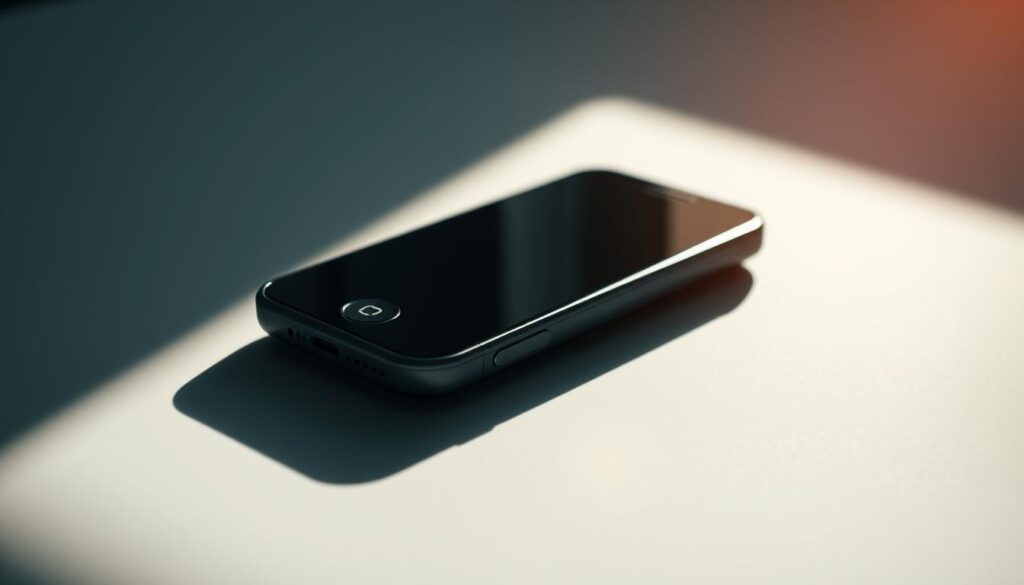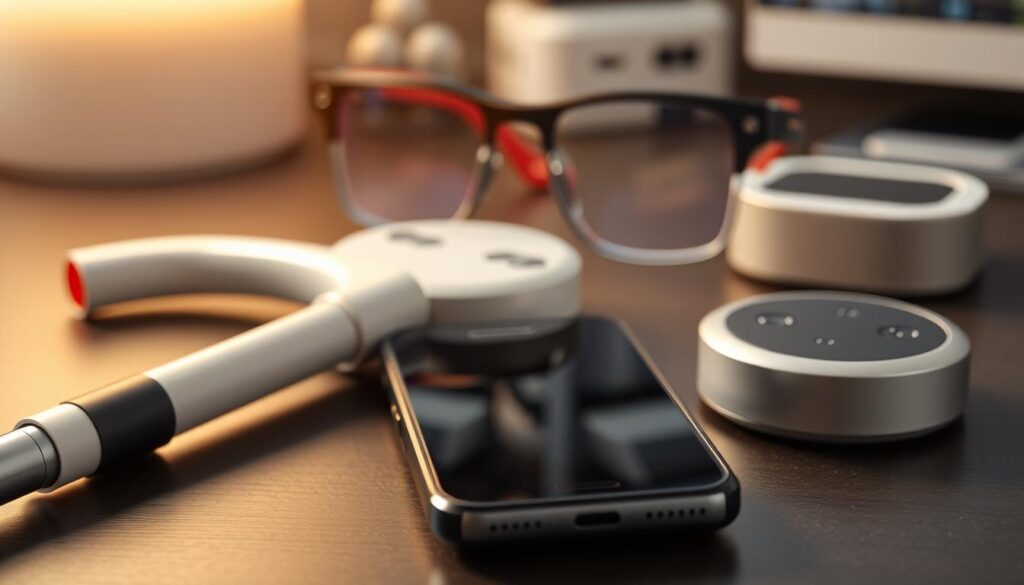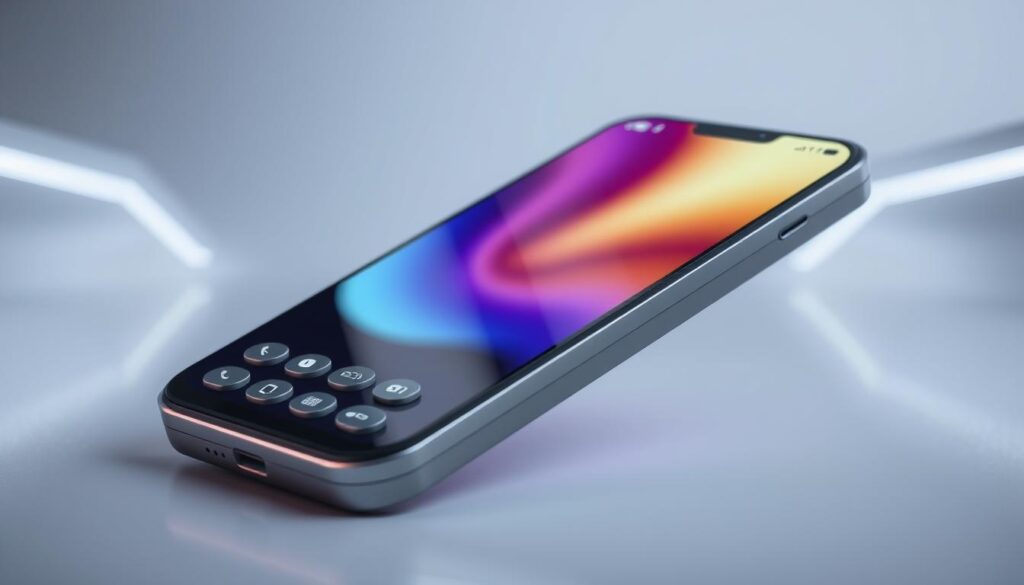Smartphones are now a key part of our daily lives. For the blind, an accessible smartphone can change everything. New touch technologies are making smartphones for the blind a reality. This means an accessible smartphone is now a must-have, not just a luxury.
Companies are working hard to create phones that the visually impaired can use easily. These phones help the blind stay independent and feel included.

Accessible technology is very important. It greatly improves the lives of the visually impaired. With an accessible smartphone, they can connect with the world, get information, and keep in touch with family.
The future of smartphones looks bright for the visually impaired. New ideas and solutions are coming to make phones more accessible.
Key Takeaways
- New touch technologies are transforming the smartphone experience for the blind
- An accessible smartphone is essential for promoting independence and inclusivity
- Visually impaired phone solutions are becoming more mainstream
- Accessible technology has a significant impact on the lives of visually impaired individuals
- The future of smartphone technology looks promising for the visually impaired
The Evolution of Smartphone Accessibility
Smartphone technology has changed a lot over the years. One big change is in making phones more accessible. Now, assistive technology for the blind lets visually impaired people use phones in new ways. They can navigate and use their devices more easily thanks to smartphone features for visually impaired.
The introduction of blind-friendly smartphone tech has been a big help. It has overcome old problems like no tactile feedback and limited voice help. For example, haptic feedback and tactile displays make using phones more natural and fun.
Some key features of assistive technology for the blind are:
- Screen readers that provide audio feedback
- Gesture-based controls for navigation
- High-contrast display modes for improved visibility
As more people want smartphone features for visually impaired, makers are coming up with new ideas. The growth of blind-friendly smartphone tech is making life better for the visually impaired. It’s also making phones better for everyone. We can look forward to even more cool tech in the future.
Understanding Modern Smartphone for the Blind Solutions
Smartphones have become much more accessible for the blind and visually impaired. A key feature is the screen reader phone. It lets users navigate and interact with their device through sound. Also, accessible mobile devices are made with accessibility in mind. They have features like high-contrast displays and tactile buttons.
There are many smartphone accessibility options to choose from. Some popular ones include:
- Screen readers with customizable voices and speech rates
- Gesture-based controls for easy navigation
- High-contrast display modes for improved visibility
These solutions have changed how blind and visually impaired people use their smartphones. With screen reader phone technology and accessible mobile devices, they can stay connected and enjoy entertainment anywhere. As technology keeps improving, we’ll see even more smartphone accessibility options.
Breakthrough Touch Interface Technologies
New touch interface technologies are changing how blind people use smartphones. An accessible smartphone is now a reality, thanks to better haptic feedback, tactile displays, and voice commands. These features make using a smartphone for the blind more natural and fun.
Some of the key features of these breakthrough technologies include:
- Haptic feedback systems that provide tactile feedback to users, allowing them to navigate and interact with their visually impaired phone more easily.
- Tactile display innovations that raise and lower braille dots to create a dynamic reading experience.
- Voice command integration that enables users to control their smartphone for the blind with simple voice commands.
These technologies are making it easier for blind people to use their accessible smartphone. They can now stay connected, find information, and move around more easily. As these technologies keep getting better, we’ll see even more ways to help blind people.
Screen Reader Advancements and Voice Assistance
Recently, screen reader technology and voice assistance have made big strides. This has changed how visually impaired people use their smartphones. Now, assistive technology for the blind is more advanced, thanks to better algorithms and natural language processing.
Smartphones for the visually impaired have also gotten better. They now have advanced voice commands and tactile feedback. These features help visually impaired people use their phones more easily and independently. For instance, some phones let users take photos and videos just by using voice commands.
Some key benefits of these improvements are:
- Improved accessibility and usability for visually impaired users
- Enhanced independence and confidence in using smartphones
- Increased opportunities for social interaction and communication

As assistive technology for the blind keeps getting better, we’ll see even more cool features. With advanced screen reader tech and voice assistance, smartphones are becoming more accessible. This opens up new ways for visually impaired people to connect and interact with the world.
Innovative Navigation Features
Smartphone makers are always working on new ways to help visually impaired users. They’re adding advanced screen reader phone features and making devices easier to use. This means users can get around their phones more easily and on their own.
Some of the key innovative navigation features include:
- Gesture-based controls, which allow users to interact with their devices using intuitive hand movements
- Audio mapping technology, which provides users with a mental map of their surroundings through audio cues
- Spatial recognition systems, which enable devices to understand the user’s physical environment and provide relevant information
These features are changing how visually impaired people use their phones. For instance, they can use gestures to move through menus. Audio mapping helps them understand where they are. And spatial recognition systems give them info about their surroundings.
By adding these features, phone makers are making devices more accessible. This is a big deal for visually impaired users. It lets them stay connected, find information, and move around more easily.
| Feature | Description |
|---|---|
| Gesture-based controls | Allow users to interact with their devices using intuitive hand movements |
| Audio mapping technology | Provide users with a mental map of their surroundings through audio cues |
| Spatial recognition systems | Enable devices to understand the user’s physical environment and provide relevant information |
Customization Options for Visually Impaired Users
Visually impaired people can enjoy many customization options on their smartphone for the blind. These include display settings, font sizes, and color schemes. Each option can be adjusted to fit the user’s needs, making their accessible smartphone experience better.
Some important customization options are:
- High contrast modes to improve visibility
- Large font sizes and bold text to aid readability
- Color inversion to reduce eye strain
- Customizable button layouts to simplify navigation
These features are especially helpful for users of visually impaired phone devices. They let users make their phone their own, making it easier to use.
With these customization options, accessible smartphone devices help visually impaired people control their mobile experience. They stay connected and engaged with the world.
Real-World Applications and Success Stories
Assistive technology for the blind has changed how visually impaired people use smartphones. Now, they can easily navigate and use apps thanks to blind-friendly features. This technology helps students use digital textbooks and resources in school.
In the workplace, blind-friendly features help visually impaired employees do their jobs well. They can access company databases and talk to colleagues. It also makes daily tasks easier, like using public transport, shopping online, and staying in touch with loved ones.
Here are some examples of how assistive technology has made a difference:
- Education: Assistive tech has made school better for students, making learning more accessible.
- Employment: Blind-friendly features have helped visually impaired people find jobs and grow in their careers.
- Daily Life: These features have made everyday activities like shopping, banking, and socializing easier.
The effect of assistive technology on visually impaired people’s lives is huge. As technology keeps getting better, we’ll see even more ways to make life easier for them.
The Future of Accessible Smartphone Design
Technology keeps getting better, and so does smartphone design for everyone. Soon, screen reader phones will be even easier to use. This means people with visual impairments can use their phones more easily and on their own.
Smartphones will soon be part of our daily lives in big ways. For example, schools can make learning better for everyone. Also, game makers can create games that work with screen readers, so everyone can play.
Here are some cool things we might see:
- Improved ways to find your way on public transport
- More accessible places to visit
- Better ways to talk and share with others
As more people want phones that are easy to use, makers need to keep improving. This way, everyone can join in the digital world, no matter their sight.

Cost Considerations and Available Support Programs
Getting a smartphone for the blind or an accessible one can be very expensive. This makes it hard for many people to afford. But, there are support programs that can help make these phones more affordable for those who need them.
Government programs offer financial help to buy an accessible smartphone. These programs can make it easier for people to get the phones they need. Non-profit groups also offer resources and support to help people get these devices.
Government Assistance Programs
- Medicaid and Medicare programs
- Veterans Administration benefits
- State-specific programs for visually impaired individuals
Non-Profit Resources
- National Federation of the Blind
- American Foundation for the Blind
- Local organizations providing assistive technology support
There are also insurance options to help pay for an accessible smartphone. Some insurance plans cover assistive technology, including phones for the visually impaired. It’s important to look into these options to find the best support for your needs.
Conclusion: Transforming Lives Through Touch Technology
Touch technology has changed how people who are blind use smartphones. It has made digital access easier and more intuitive. This includes new ways to feel and hear on phones.
Now, blind users can easily move around their phones and get information. This has made their lives better and more independent. It has also helped them feel included in the digital world.
The future of phones for the blind looks bright. There will be even more ways to use touch technology. Thanks to government help and non-profits, these tools will be more affordable. This means more people will get to enjoy the benefits of touch technology.
FAQ
What are the traditional barriers to smartphone use for the visually impaired?
The main barriers include small screens, complex interfaces, and missing features like screen readers. These make it hard for the visually impaired to use smartphones.
How have adaptive technologies helped to address these barriers?
Adaptive tech like screen readers and haptic feedback has made smartphones more accessible. It lets users interact through touch, sound, and voice.
What are some of the key features of modern smartphone solutions for the blind?
Modern solutions include screen readers, tactile displays, and voice assistants. These features offer auditory and haptic feedback, helping users navigate and interact better.
How do haptic feedback systems and tactile display innovations improve smartphone accessibility?
Haptic feedback gives users tactile cues, like vibrations, to find on-screen elements. Tactile displays, like raised buttons, make the interface more tangible.
How have advancements in screen reader technology and voice assistance improved smartphone accessibility?
Screen reader and voice assistance advancements have greatly improved accessibility. They use advanced algorithms for auditory feedback and voice control.
What types of innovative navigation features are being developed to improve smartphone usability for the blind?
New features include gesture controls, audio mapping, and spatial recognition. These enable users to navigate through gestures, sound, and spatial awareness.
What customization options are available for visually impaired users to optimize their smartphone experience?
Users can customize their experience with display settings, font sizes, and color schemes. These options enhance readability and contrast, making the interface more accessible.
How are accessible smartphones being implemented in educational and workplace settings?
Accessible smartphones are being used in schools and workplaces to support visually impaired individuals. They help with digital access, communication, and work tasks.
What government assistance programs and non-profit resources are available to support the acquisition of accessible smartphones?
There are government programs and non-profit resources for accessible smartphones. They offer funding, device loans, and educational resources. These help visually impaired individuals get the technology they need.